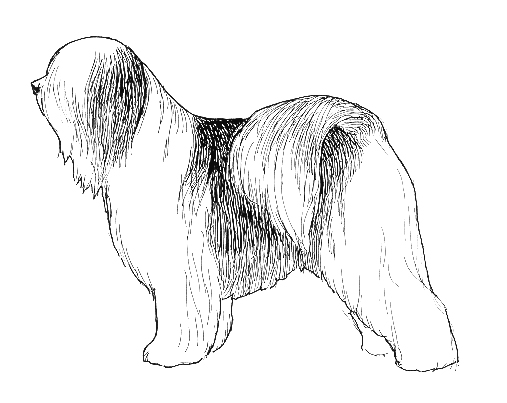Tibetan Terrier
Companion Dog Group
The goals and purposes of this breed standard include: to furnish guidelines for breeders who wish to maintain the quality of their breed and to improve it; to advance this breed to a state of similarity throughout the world; and to act as a guide for judges.
Breeders and judges have the responsibility to avoid any conditions or exaggerations that are detrimental to the health, welfare, essence and soundness of this breed, and must take the responsibility to see that these are not perpetuated.
Any departure from the following should be considered a fault, and the seriousness with which the fault should be regarded should be in exact proportion to its degree and its effect upon the health and welfare of the dog and on the dog’s ability to perform its traditional work.
History
The Tibetan Terrier is not a terrier at all, but is an ancient Tibetan herding breed, believed to be the progenitor of the Lhasa Apso and other Eastern European herding breeds. It was also used as a guard dog of the Tibetan monasteries and was often referred to as a "holy dog" and was thought to bring good luck.
The Tibetan Terrier was recognized by the United Kennel Club in 1973.
General Appearance
The Tibetan Terrier is a medium sized, powerfully built, square breed with a profuse coat that comes in a variety of colors. It has large, flat feet and a high set tail that curls over the back.
Characteristics
The breed is highly intelligent, sensitive, loyal, devoted and affectionate. They may be cautious or reserved with strangers.
Head
The head is well furnished with long hair that falls over the eyes and the foreface.
SKULL
The skull is of medium length and width, slightly wider at the ear than at the eye. It is slightly rounded in shape, and there is a marked stop.
MUZZLE
The muzzle is strong, with a well-developed lower jaw. The length of the muzzle is equal to the length of the skull. The cheeks are well-developed, but not bulging.
NOSE
The nose is always black.
Fault: Nose any other color than black.
TEETH
A full complement of strong, white teeth meet in a scissors, even or reverse scissors bite. The incisors are set in a slight curve between the canine teeth.
Faults: Overshot bite. Very undershot. Wry mouth.
EYES
The eyes are large, dark brown in color and set fairly wide apart. The eyelids are dark in color.
Faults: Prominent or sunken eyes.
EARS
Pendant, V-shaped ears fall not too close to the head. They are heavily feathered and should not be too large.
Neck
The length is in proportion to the body and the head. It is well set on, slightly arched and is carried erect.
Forequarters
The shoulders are sloping, well laid back, and are well muscled.
FORELEGS
The forelegs are straight and strong when viewed from the front, and are heavily furnished. The distance from the withers to the elbow equals the distance from the elbow to the ground. The pasterns slope slightly. Dewclaws may be removed.
Body
The body is compact, square and strong. The chest is deep, and the ribs are well-sprung. The topline is level to the loin, which is short, strong and slightly arched. The croup is flat to the set on of the tail.
Hindquarters
Fairly broad, and well-muscled.
HIND LEGS
The hind legs are well bent at the stifle, with low set hocks. Dewclaws may be removed.
Feet
The feet are unique, being large, flat and round in shape, producing a snowshoe effect that provides traction. There is no arch in the toes. The feet are heavily furnished with hair between the toes and the pads.
Tail
The tail is of medium length and is heavily furnished. It is set on fairly high and falls forward over the back. It may curl to either side. There may be a kink near the tip.
Coat
The Tibetan Terrier has a profuse, double coat. The undercoat is soft and woolly. The outer coat is long and fine. It may be wavy or straight.
Note: Sculpting, scissoring, stripping and/or shaving are totally contrary to breed type and are serious faults.
Color
Any color or combination of colors, including white, are acceptable.
Gait
At a trot, the gait is smooth and free, with good reach and powerful drive. There should be a tendency to single track.
Height & Weight
The average height for males is 14 to 16 inches. Slightly less for females.
Weight range is approximately 18 to 30 pounds.
Disqualifications
(A dog with a Disqualification must not be considered for placement in a conformation event, and must be reported to UKC.)
Unilateral or bilateral cryptorchid.
Viciousness or extreme shyness.
Albinism.

Looking for a Dog?
Find a dog that will fit your family.
Note: The breeders on this list are not endorsed by UKC.
Revised May 1, 2007
©Copyright 1991, United Kennel Club
